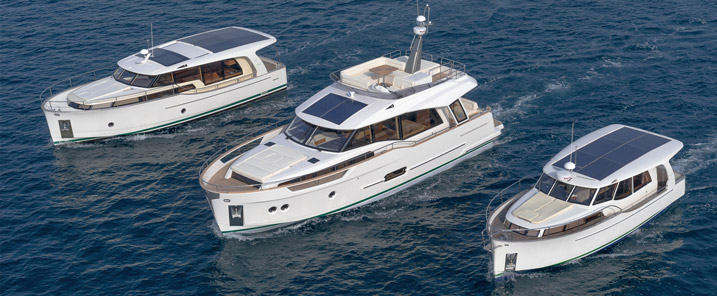
Jurij korenc / CC BY-SA (https://creativecommons.org/licenses/by-sa/4.0)
Hybrid yachts, much like hybrid cars, are yachts that employ the use of both conventional and electric engines. More specifically, the drivetrain in a hybrid yacht relies on two or more power sources for both propulsion (moving the yacht forward) and onboard needs like air conditioning. In most cases, the two power sources are a diesel or gas engine and an electric motor, either working in tandem or side by side for different purposes.
Why would you consider a hybrid yacht? And what should you consider before you buy one?
The Benefits of Hybrid Yachts
Let’s dig into some of the most important benefits that hybrid yachts have over conventional yachts:
- Environmental considerations. First, and perhaps most obviously, relying on a hybrid yacht or an electric yacht can have a benefit for the environment. Traditional combustion engines produce greenhouse gas emissions—gas compounds that contribute to the “greenhouse” effect that’s largely responsible for climate change. The bigger the load of the engine, the more powerful the effect is—so if you’re operating a gigantic yacht with a combustion engine alone, you’ll be producing far more emissions than you would traveling a similar distance in a conventional motor vehicle. By transitioning to a model that utilises electric power as much as possible, you’ll be able to ride cleaner, reducing your carbon footprint.
- Energy savings. It’s also possible to save money on powering your yacht with the hybrid model—especially if you invest in a unit with built-in solar panels. Generally speaking, the power produced by an electric motor will cost you less than an equivalent amount of power generated by a combustion engine. If you’re buying a yacht, money may not be a major concern, but over the lifetime of your ownership, your ongoing costs could plummet if you’re at least partially relying on electric power.
- Silent cruising. Newcomers to the hybrid yacht scene are often surprised at how quiet hybrid yachts are. When operating in electric mode, a yacht can produce far less sound—in some cases as low as 46 decibels, or noise equivalent to the sound of gently falling rain. If you’re interested in enjoying pleasant conversation with others, or just relaxing as deeply as possible, the excess noise from a combustion engine could be extremely distracting. With a hybrid yacht, you can instantly reduce, or even eliminate this noise, cruising in near silence without sacrificing your speed.
- Size and spacing flexibility. It may seem like a yacht with two power sources would have less flexibility when it comes to engine spacing and placement, but the opposite is actually true. Hybrid setups are more compact than you might imagine, capable of supporting even superyachts with minimal space. Additionally, electric motors are driven by batteries and/or generators, which can be placed anywhere on board—giving designers much more flexibility for accommodation. In other words, you won’t have to worry about a gigantic engine room in the middle of the ship taking up all the space you’d prefer to use for relaxing.
- Preservation of power. Relying on the electric motor alone, most hybrid yachts can achieve speeds of 6 knots or more, matching the cruising speed you might expect from a yacht of similar size. But if you’re interested in moving faster, or if you need more powerful performance, you’ll still have it; you’ll be able to tap the combustion engine to make your vessel move.
- Reputation and confidence. It’s also worth noting some of the subjective benefits of owning a hybrid yacht. Knowing you’re doing your part for the environment could help you feel more confident cruising in it, and you may earn reputational benefits as a thought leader in your niche.
All these benefits come naturally with hybrid yachts, without pushing the initial costs of buying one far above a conventional yacht.
Finding a Hybrid Yacht
One of the only downsides of a hybrid yacht is that they may be difficult to find, and may not be as innovative as their hybrid automotive counterparts. Boating in general is a somewhat niche market; not everyone has access to water, and not everyone with access to water is interested in boating. Accordingly, lower demand restricts innovation, and yacht manufacturers often follow their contemporaries in other fields.
Currently, less than 2 percent of the new boats emerging on the market today are utilizing hybrid or electric propulsion. This is partially due to the sheer number of different types of boats that exist; for example, ferries, sailboats, planers, and cruising yachts are all very different types of vessels, and not all of them would benefit from a hybrid system the same way.
Fortunately, there’s been a big push to introduce more hybrid yachts to the market, and the adoption curve has been favourable. You might not be able to find as many hybrid yachts as you will yachts with conventional combustion engines, but they’re growing in number, diversity, and availability.
Charging Your Hybrid Yacht
In most cases, you’ll need to think about charging the electric motor on your hybrid boat, much like you’d charge an electric car. However, there are numerous innovations that have made this simpler, more accessible, and less limiting than you might think.
For starters, most hybrid yachts are equipped with high-power battery systems, which allow you to store more power and last longer on the open water. Many hybrid yachts also come equipped with solar panels, which allow you to gather and utilise energy from the sun without having to stop at an electric station. On top of that, serially connected hybrid boats feature a combustion engine-powered generator, which powers an electric motor connected to the driveshaft—allowing you to get further with the help of combustion power.
Are you interested in getting a hybrid yacht of your own? Browse our selection of hybrid yachts today, including new and used models from all around the world, and you’ll be able to find the perfect fit for your needs.